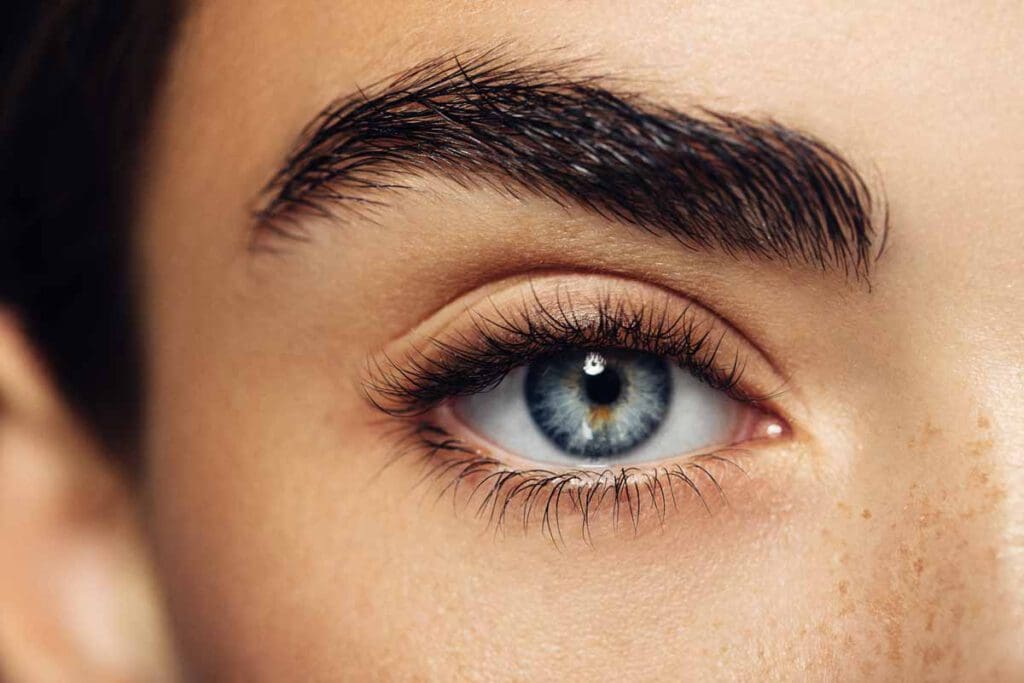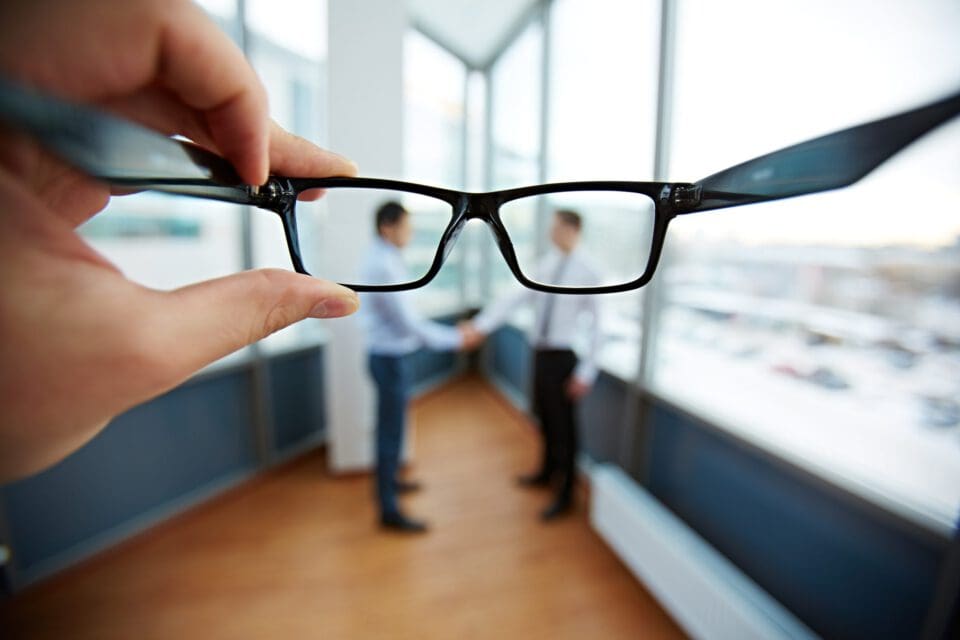
Medically Reviewed by Tom Tooma, M.D., Founder/Medical Director NVISION Surgeon
Glasses After LASIK: Why Some Patients Might Need Them
Home / Everything About Glasses /
Last Updated:

Medically Reviewed by Tom Tooma, M.D., Founder/Medical Director NVISION Surgeon
When Eyeglasses Are Necessary
Although significant advancements have been made in corrective vision surgeries like LASIK, there are instances when eyeglasses may still be necessary or a more appropriate correction choice. People experiencing presbyopia, for example, are still most commonly recommended reading glasses to make up for the changes in their vision.
There are various signs that you may need eyeglasses.
- Blurred vision
- Double vision
- Objects appearing fuzzy
- Headaches
- Squinting
- Halos around objects in bright light
- Eyestrain
- Distorted vision
- Trouble seeing and driving at night
- Eyeglasses are a relatively simple fix that can alleviate the above symptoms.
If you are experiencing any of these conditions, speak with an eye doctor about your potential need for corrective lenses. According to the American Academy of Ophthalmology, over 150 million Americans use some form of corrective eye wear. If you need a corrective vision intervention, but prefer not to undergo surgery, eyeglasses are a very effective and common solution.
Table of Contents
LASIK surgery has a very high success rate at helping people reduce their dependence on using glasses or corrective lenses throughout the day. LASIK has been scientifically developed to provide significant improvement in vision for those suffering from conditions like myopia, hyperopia, and astigmatism.
While LASIK can greatly reduce use of glasses or contact lenses throughout the day, it does not claim to eliminate the need fully. Everyone responds to the surgery slightly differently. Depending on age and other vision conditions, glasses may still be needed after LASIK, particularly for reading.
Certain eye conditions, such as presbyopia, are not typically treated through LASIK. Presbyopia is a natural condition that everyone experiences to some degree as they age. As of yet, LASIK is not an approved treatment in the U.S. for presbyopia.
For people in need of vision correction, there are many options available. There are various FDA-approved surgical approaches to vision correction, which includes LASIK. Some people, however, may not qualify or desire surgical interventions. For these people, glasses are a simple and effective solution.
When doctors speak to their patients about the possibility of getting LASIK, they are cautious about setting the correct expectations. Some people experience better than 20/20 vision following LASIK, but that is not the outcome for everyone. The goal of LASIK is to improve people’s vision enough so they don’t have to rely on glasses or corrective lenses for the majority of their day.

When Is LASIK Appropriate?
LASIK is a type of eye surgery that is meant to reduce people’s dependence on glasses, though it may not eliminate the need for them entirely.
LASIK improves vision by making surgical changes to the shape of the cornea using highly specialized lasers, explains the U.S. Food and Drug Administration (FDA). When the shape of the cornea and eye are not perfect, the image on the retina may appear blurred or out of focus. Refractive errors like this are what LASIK is able to improve.
You deserve clear vision. We can help.
With 135+ locations and over 2.5 million procedures performed, our board-certified eye surgeons deliver results you can trust.
Your journey to better vision starts here.
The three main types of refractive errors that LASIK can help with are:
- Also known as nearsightedness, myopia causes people to have a hard time seeing things that are far away clearly.
- Also known as farsightedness, hyperopia means people have a difficult time clearly seeing objects that are close.
- Irregularities on the cornea or lens of the eye cause a distortion of the image on the retina, referred to as astigmatism.
For people suffering from myopia, hyperopia, astigmatism, or a combination of astigmatism and one of the other two conditions, LASIK surgery can make corrections that will make images clear again.
LASIK surgery works by removing layers of tissue on the cornea until a more optimal shape is achieved. A laser is used to reshape the cornea so the eye can focus in any situation.
Needing Glasses After LASIK

Studies have found that about 95 percent of patients have 20/40 vision or better following LASIK surgery. About 80 percent of patients experience 20/20 vision or better.
LASIK is a permanent procedure that irreversibly changes the shape of your cornea. Nonetheless, your vision will not remain optimum for life even after the surgery.
Aging usually causes morphological changes in the body and the eye is no exception. Typically, from 40 years of age and older, presbyopia sets in. Near-vision becomes a challenge.
Conventional LASIK surgery does not correct presbyopia. As a result, you will need glasses for reading or driving despite the previous eye operation.
Issues Stemming From Presbyopia
There are certain situations where people are likely to still need glasses for some things after LASIK. Issues stemming from presbyopia, for example, are not typically treated through LASIK. Presbyopia is a normal eye condition that occurs with age where you lose the ability to focus clearly on objects that are near to you.
In general, LASIK is used for the correction of distance vision and refractive errors, neither of which are caused by presbyopia. The FDA has not approved the use of LASIK surgery to treat presbyopia, but research is building in support of using LASIK for this. In fact, PresbyLASIK, a multifocal approach to the LASIK procedure has already been used for many years in Europe.
Only recently has refractive laser technology become advanced enough to be able to safely address presbyopia. Today, it is possible to use a laser blended vision approach to increase the ocular depth of the field of vision. This allows for binocular vision to be achieved at both near and far distances. Using LASIK surgery to correct issues stemming from presbyopia is a cutting-edge approach that many doctors are confident will become the standard of care within the next 10 years.
You deserve clear vision. We can help.
With 135+ locations and over 2.5 million procedures performed, our board-certified eye surgeons deliver results you can trust.
Your journey to better vision starts here.
The Correlation Between Age and Reading Glasses

According to the American Optometric Association, one of the most common problems that adults between the ages of 40 and 60 experience is difficulty seeing things up close, particularly related to reading or doing things on the computer. Presbyopia is to blame for the change in the eye’s focusing ability, and it is a degenerative condition.
Around the age of 40, people often start to experience a decrease in their ability to focus on small text in front of them. This can make reading things, including what is on your computer or phone, very challenging. With age, the lens of the eye becomes less flexible, making it increasingly difficult to focus on things up close.
As the general population in the United States gets older, the cases of presbyopia in the country rise. In 2006, the U.S. Census Bureau reported that 112 million Americans experienced issues stemming from presbyopia, with the number expected to reach 123 million by 2020. Worldwide, roughly 1.3 billion people dealt with presbyopia in 2011, with predictions of over 2 billion people affected by presbyopia by 2020.
As our eyes become less elastic and more rigid over time, we are likely to need reading glasses to make minor adjustments. Because not all eye conditions, such as presbyopia, can be treated through LASIK surgery, reading glasses or progressive lenses are one of the most common solutions to simple eye problems experienced by people over the age of 40.
Different Types of Vision Correction
LASIK is just one of many different types of vision correction surgeries that are available today. While LASIK is one of the more well-known approaches, other options exist that may be more appropriate for certain conditions.
Additional types of vision correction include:
- Radial keratotomy.
- Laser vision correction.
- Photorefractive keratectomy.
- Laser thermal keratoplasty.
- Intracorneal ring segments.
- Phakic intraocular lens implants.
- Presbyopic refractive lens exchange.
- Clear lens extraction.
For people who qualify, vision correction surgery can be a life-changing experience. Significant advancements have been made over the last few decades in the safety and effectiveness of vision correction techniques. All surgeries come with risks, however, so if you are considering getting vision correction surgery, speak with your doctor about all of the potential risks and benefits of surgery.
You deserve clear vision. We can help.
With 135+ locations and over 2.5 million procedures performed, our board-certified eye surgeons deliver results you can trust.
Your journey to better vision starts here.
References
- Adult Vision: 41 to 60 Years of Age. (2019). American Optometric Association.
- Do I Need Glasses? (March 2018). Healthline.
- Is LASIK a Viable Solution for Presbyopia? (July 2018). The Ophthalmologist.
- Statistical Snapshots from the American Foundation for the Blind. (August 2021). American Foundation for the Blind. Date fetched: August 4, 2021.
- Laser Surgery Can Improve Vision Problems. (August 2021). University of Rochester Medical Center. Date fetched: August 4, 2021
- Understanding the Facts About LASIK Enhancements. (October 4, 2018). Refractive Surgery Council. Date fetched: August 4, 2021.
- LASIK. (March 26, 2018). U.S. Food & Drug Administration. Date fetched: August 4, 2021.

Dr. Tooma, the founder of NVISION® Eye Centers, has performed well over 130,000 LASIK surgeries, making him the most experienced LASIK surgeon in the Western United States.
This content is for informational purposes only. It may have been reviewed by a licensed physician, but is not intended to serve as a substitute for professional medical advice. Always consult your healthcare provider with any health concerns. For more, read our Privacy Policy and Editorial Policy.
